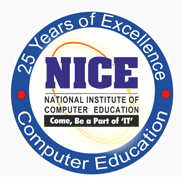CCNA course is offered by NICE (National Institute of Computer Education Pvt. Ltd). NICE-National Institute of Computer Education Pvt. Ltd., is one of the Pioneer Computer Training Institute of the Country setting quality standards for ‘IT Education’.

CCNA course is offered by NICE (National Institute of Computer Education Pvt. Ltd). NICE-National Institute of Computer Education Pvt. Ltd., is one of the Pioneer Computer Training Institute of the Country setting quality standards for ‘IT Education’.
Quality Education & Training from NICE have become synonymous. This is reflected by the acceptance of NICE Certificates by all and utilization of its Services by MNCs, Public & Private Sector Organizations, Government Departments, Universities, Colleges, Etc.
Course Structure:
NICE-National Institute of Computer Education Pvt. Ltd., is one of the Pioneer Computer Training Institute of the Country setting quality standards for ‘IT Education’.
NICE is a Corporate Entity with Regd. Office at Cuttack & Corporate Office at Bhubaneswar (Odisha). It has a nationwide network of E-connected Authorized Training Centers across the Country and more than 50 Training Centers across Odisha itself.
NICE was established in Cuttack, more than 2 decades ago in the year 1993, by the Young & Dynamic, Technocrat Entrepreneur Ms. Neeta Agarwal.
The Advisory Board, Board of Directors and Board of Studies of NICE Consist of eminent personalities form different walks of life renowned in their respective fields. It is a unique combination of Academicians, Management Consultants, Legal Luminaries, Accountants and Technocrats.
NICE Believes in the principle that High-Quality Human Resource is the greatest asset of an Education & Training Organization. To put it in a nutshell, it is a model professionally managed company.
Quality Education & Training from NICE have become synonymous. This is reflected by the acceptance of NICE Certificates by all and utilization of its Services by MNC’s, Public & Private Sector Organizations, Government Departments, Universities, Colleges, Etc.,
NICE is credited with the distinction of being the 1st Institute in Odisha to conduct Distance Education Courses in association with the State Govt. University. NICE for its quality education and training had got the accreditation by Doeacc Society, (A scheme of DoE-AICTE) under the Ministry of Information Technology, Govt. of India, to conduct ‘O’ level & CCC courses (2000-2003).
It is the Authorized Training Center for Tata Consultancy Services (Ex-NGN) and was one of Odisha’s First Authorized Tally Academy. Some centers of NICE are also the AVI of NIOS, under the Ministry of Human Resource & Development, Govt of India. NICE was the exclusive Service Provider of Sambalpur University (2000-2010) to offer Degree level courses – BCA, BBA and Post Graduate level courses MBA, MCA & PGDCA.
NICE is the Authorized Study Center of Karnataka State Open University and also the Learning Center of Punjab Technical University. NICE, was one of the selected partners of Govt. of Odisha (Dept. of Higher Education) for providing computer education in different Govt. & Aided colleges of Odisha.
NICE is the Deployment Partner of Certiport (A Pearson Vue Business) for facilitating the Microsoft Office Specialist (MOS) Exam in Odisha. All students who receive laptops (2014-15, 15-16, and 2016-17) from Govt. of Odisha have an opportunity to appear for MOS Exam. NICE is also a Certiport Authorised Testing Centre (CATC).
NICE was selected by IES, New Delhi to receive the prestigious Excellence Award and Gold Medal for contribution in the field of Education, Corporate And Social responsibility.
© 2025 coursetakers.com All Rights Reserved. Terms and Conditions of use | Privacy Policy